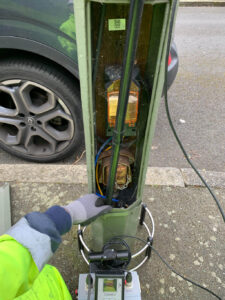Editing Notes
– Replace picture ? Add Colchek diagram?
– What is the depth of corrosion monitoring?
Focus on Quality
Corrosion at or below ground level is greatest risk to planted (rooted) lighting columns. Loss of material due to corrosion will progressively weaken the column until collapse occurs.
Corrosion is greatest at just above and just below ground level. i.e. In areas that are subject to the longest exposure both moisture and oxygen. Corrosion is accelerated by the presence of acids (decay of organic matter and dog urine) and de-icing salt.
Planted columns are normally designed to resist corrosion by a combination of coating and galvanising. Paint type coatings prevent corrosion by preventing access by moisture and atmospheric oxygen. Galvanising prevents corrosion of the structure by sacrificing itself.
Corrosion will not occur if the base metal is
a) Coatings only provide protection as long as metal surface remains perfectly sealed.
b) Galvanising only provide protection until the zinc coating is “used up”.
The solution
In a perfect world, lighting columns would be built from materials that did not corrode. Protective coatings would never degrade. However, such ideal solutions are not economic. The only practicable option is to use economically available materials with economically available corrosion protection. However, corrosion must be monitored to ensure the risk of failure always remains low.
Caspian use “Eddy Current Testing” to assess loss of material due to corrosion. Eddy current testing is achieved by inducing electric currents in the lighting column using an external drive coil. A detector coil is inserted into the column to measure the strength of the electric field. The strength of the electric field is measured at various locations. Material loss below ground is assessed by comparing the electric field from known wall thickness above ground with that below ground.
Knowing the material loss allows the remaining safe working life of the lighting column to be assessed.

Why Choose Us
Quality always comes first at Caspian NDT. That means we pore over every minute detail throughout the entire inspection process.
We are flexible
We continuously strive to meet our client requirements and work independently or as part of a multi-disciplined team within your premises or on-site at construction, fabrication projects.
Professionals Only
Our technicians are extremely well qualified and experienced and meet our exacting standards of skill, professionalism and commitment. Because we often work within hazardous situations, we always follow stringent safety guidelines in accordance with the relevant legislative requirements.
What Our Customers say
Caspian Ndt have been providing us with exceptional non-destructive testing services. both at our base at Manchester and overseas.
We have found the Non-Destructive Testing services from Caspian ndt Ltd to be of the highest level. They have exceptional knowledge of NDT processes and issue comprehensive reports within 3 days of any works being completed.







